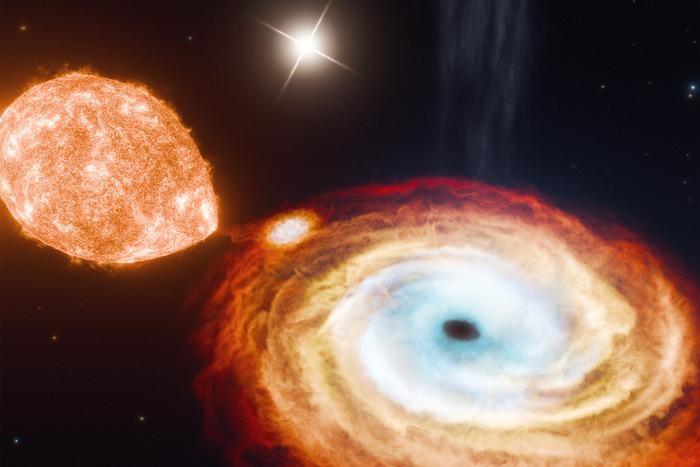
Astrophysicists have discovered a “black hole triple,” where some delicate physics is keeping two stars located 8,000 light-years away finely tethered to a black hole.
Black holes are scary. The idea of anything being so powerful that not even light can escape its pull is enough to set the mood for Halloween. But not all black holes have the same origin stories. To explain the triple system’s existence, astrophysicists propose that this black hole formed gently.
“We think most black holes form from violent explosions of stars, but this discovery helps call that into question,” Kevin Burdge, co-author of the new study and astrophysics researcher at the Massachusetts Institute of Technology (MIT) said in a university announcement. A paper explaining the study was published Wednesday in the journal Nature.
What’s in the black hole triple?
The leader of this trio, called V404 Cygni, is a black hole that is extracting material from the triple’s second member, a small star so incredibly close to the black hole that it orbits once every week.
But the third party is weird. It’s another star that takes a whopping 70,000 years to circle the black hole once. The outer star’s beleaguered journey around the black hole stems from the massive distance between the two. The MIT announcement compared it to “equal to 100 times the distance between Pluto and the Sun.”
This long-distance relationship allows astrophysicists to peer back in time. Four billion years ago, three stars were born together. When one ultimately perished, it had a gentle death, allowing the triple system to stay together.
“Imagine you’re pulling a kite,” Burdge said, referring to the outermost star, “and instead of a strong string, you’re pulling with a spider web.”
“If you tugged too hard, the web would break and you’d lose the kite,” Burdge added.
Their fragile relationship led the team, after they scoured existing astronomical data and ran tens of thousands of simulations, to suggest that the black hole had a soft birth. Black holes are remnants of the universe’s most massive stars. When these huge stars die, they often explode as violent supernovas. But if that happened around the black hole triple, the faraway star would have been jettisoned.
The simulations revealed that one good explanation is that the black hole formed via direct collapse. In this scenario, it caved in on itself, its mass shrinking into an ever smaller point to create the black hole.
It’s like a cosmic way of holding in a sneeze.







